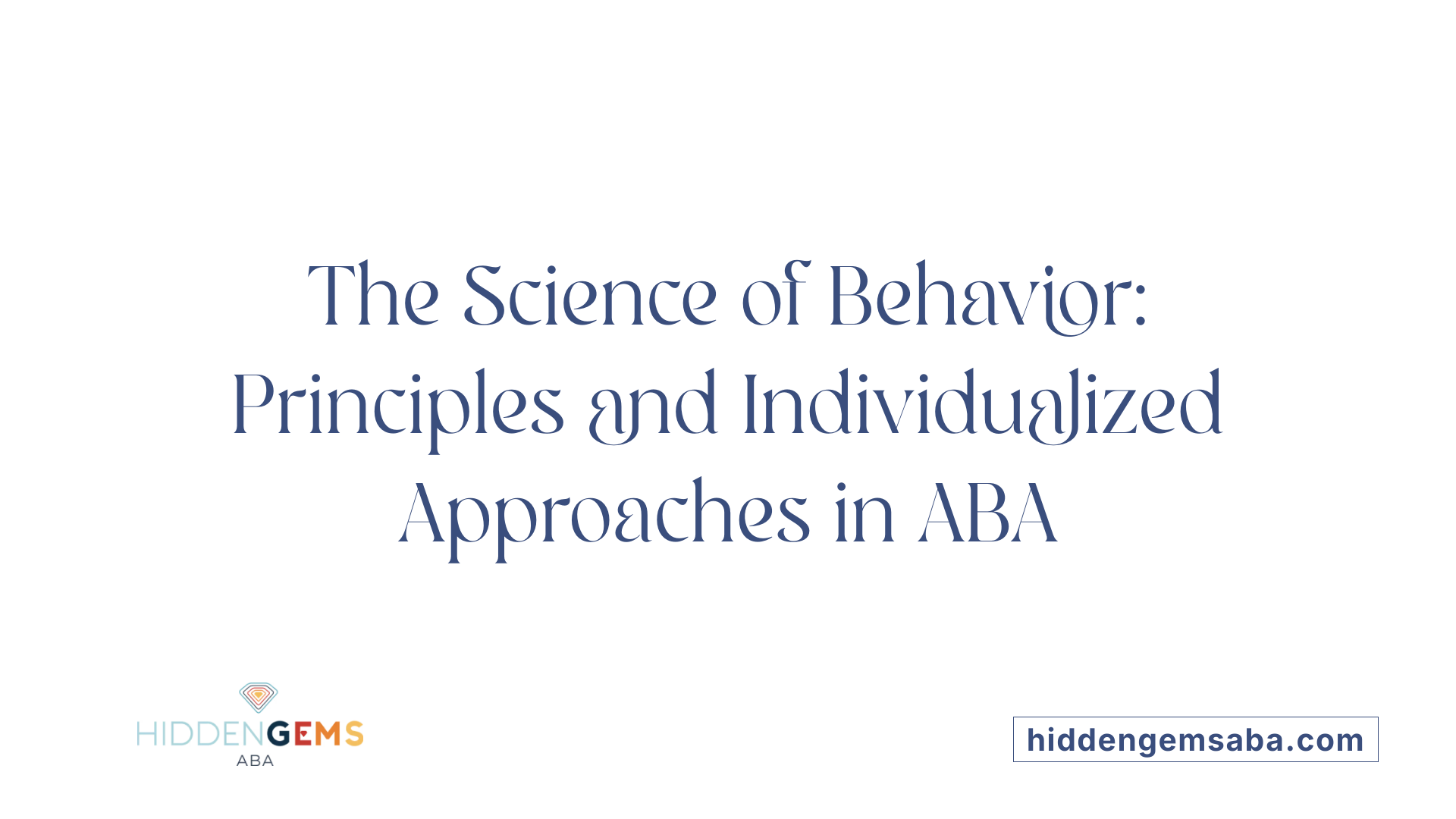Introducing ABA Therapy: A Foundation for Growth
Applied Behavior Analysis (ABA) therapy is a scientifically supported approach that helps individuals with autism spectrum disorder (ASD) develop essential life skills. Grounded in behavioral science and using environmental cues to shape actions, ABA not only improves communication and social interaction but also plays a crucial role in fostering self-discipline and responsibility. This article explores how ABA therapy nurtures these qualities, empowering individuals to lead more independent and fulfilling lives.
Understanding Behavioral Analysis Therapy for Autism

What is behavioral analysis therapy for autism?
Behavioral analysis therapy for autism, commonly known as Applied Behavior Analysis (ABA), is an evidence-based approach rooted in the science of learning and behavior. It focuses on understanding how environmental factors influence behavior and uses techniques such as positive reinforcement, prompting, and functional communication training to increase helpful behaviors and reduce harmful or challenging ones.
ABA therapy is highly individualized. Qualified professionals, such as Board Certified Behavior Analysts (BCBAs), assess each child's unique needs and develop tailored intervention plans. The therapy involves structured sessions and is delivered in diverse settings including homes, schools, and clinics. Its goal is to promote independence and improve social, communicative, and adaptive skills.
Behavioral science foundation
ABA therapy is grounded in behavioral science principles. It applies systematic methods to analyze antecedents (triggers) and consequences that influence behavior. Through this approach, desirable behaviors like communication, social skills, and daily living tasks are encouraged, while problematic behaviors such as self-injury or tantrums are reduced.
Central to ABA is the use of reinforcement strategies, where positive consequences follow desired behaviors to increase their frequency. Consistency in applying these interventions across different environments and caregivers helps sustain progress. This scientific framework ensures that interventions are data-driven, measurable, and tailored.
Techniques used
Several key techniques define ABA therapy:
- Positive Reinforcement: Rewarding preferred behaviors to encourage recurrence.
- Prompting and Shaping: Gradually guiding behaviors toward desired outcomes.
- Discrete Trial Training (DTT): Breaking skills into small, teachable steps taught one at a time.
- Generalization: Helping children apply learned skills across settings and people.
- Extinction: Reducing unwanted behaviors by withholding reinforcement.
These methods are systematically combined and individualized, allowing therapists to address challenges such as communication deficits, social difficulties, and anxiety while fostering new abilities.
Together, the scientific foundation and versatile techniques of ABA create a comprehensive framework supporting meaningful improvements in children with autism.
Who Provides ABA Therapy? Meet the Specialists Behind the Program

Who Typically Provides Behavioral Analysis Therapy for Autism?
Behavioral analysis therapy for autism is delivered by a team of qualified professionals with specialized training in Applied Behavior Analysis (ABA). At the forefront are Board Certified Behavior Analysts (BCBAs and BCBA-Ds), who conduct assessments, design personalized treatment plans, and oversee therapy implementation to ensure targeted and effective interventions. These certified experts play a central role in driving the therapy and adjusting goals based on progress.
Roles of BCBAs and Multidisciplinary Teams
Beyond BCBAs, ABA therapy often involves a multidisciplinary team including Speech-Language Pathologists, Occupational Therapists, and other specialists. This collaboration allows for comprehensive care, addressing various skill areas such as communication, social skills, daily living, and behavior modification. The team approach supports generalization of skills across settings and helps tailor interventions to fit each individual's unique needs.
Settings of Therapy Delivery
ABA therapy can take place in multiple settings like in-home sessions, community-based programs, and clinical environments. This flexibility helps optimize learning by providing real-world contexts for skill practice and behavioral change. Sessions typically involve one-on-one therapy initially, with adaptations as the individual advances. Caregiver training is also an essential component, ensuring reinforcement of learned skills beyond formal therapy hours. Together, these professionals and settings create a supportive framework geared toward fostering independence, social integration, and improved quality of life for individuals with autism.
The Science Behind ABA: How Behavior is Shaped and Changed

What Are Behavioral Principles and Analysis?
Applied Behavior Analysis (ABA) is grounded in the science of behaviorism, which studies how behavior works based on antecedents (what happens before a behavior) and consequences (what happens after). This analysis helps identify patterns to increase desirable behaviors and decrease challenging ones. ABA applies these principles systematically in real-world settings to improve socially important behaviors, such as communication, social skills, and daily living.
How Is Reinforcement Used in ABA Interventions?
A central technique in ABA is reinforcement, which involves providing positive consequences to encourage desired behaviors. Reinforcement can be positive (adding something pleasant) or negative (removing something unpleasant) based on the individual’s needs. Other intervention methods include prompting, shaping, discrete trial training, extinction, and generalization. Interventions are consistently applied across different environments to maintain and generalize improvements.
How Is Treatment Individualized in ABA?
ABA therapy is highly personalized and tailored to each individual's specific behaviors and learning pace. Qualified professionals like Board Certified Behavior Analysts (BCBAs) conduct thorough assessments to develop customized treatment plans. These plans specify session length, therapy intensity (often between 26 and 40 hours per week), and techniques used. Caregiver training is integral, ensuring skills are supported beyond therapy sessions. The ongoing monitoring and adjustment ensure interventions remain effective over time.
These evidence-based methods combine scientific rigor with practical tools to foster meaningful behavior change, making ABA a gold standard in autism therapy.
ABA Therapy's Impact on Communication and Social Skills

How does ABA therapy improve social and communicative skills in children with autism?
Applied Behavior Analysis (ABA) therapy systematically enhances social and communication abilities by employing behavioral principles such as positive reinforcement and discrete trial training (DTT). These techniques target specific behaviors, encouraging children with autism spectrum disorder (ASD) to develop social interaction skills, use functional communication, and manage daily tasks more effectively. Through repetitive, structured sessions tailored to individual needs, ABA helps build foundational communication and social routines.
What does research say about the effectiveness of ABA in these areas?
A controlled study involving 60 institutionalized boys aged 4 to 11 demonstrated significant improvements in social and communicative skills after eight one-hour ABA sessions over six weeks. The study utilized the Kindergarten Inventory of Social/Emotional Tendencies (KIST) to measure changes, revealing marked gains in social skills, communication competence, and adaptive behavior. This compelling evidence underscores ABA's role in promoting positive developmental outcomes in children with ASD.
How does ABA contribute to emotional regulation?
Beyond social and communicative gains, ABA therapy offers notable benefits in emotional regulation for children with autism. The same study found reductions in separation anxiety and improvements in emotional responses, helping children better manage feelings and behavioral challenges. Structured interventions using ABA strategies enable children to recognize triggers, learn coping mechanisms, and practice emotional control in diverse situations. This holistic development supports improved social integration and overall well-being.
Together, these findings highlight ABA's comprehensive impact in fostering communication, social skills, and emotional regulation—areas often most affected in children with autism. Early, structured ABA interventions alongside caregiver involvement enhance the potential for lasting, meaningful improvement.
Fostering Self-Discipline Through Structured ABA Interventions

How structured sessions teach self-regulation
Applied Behavior Analysis (ABA) employs carefully planned individual sessions to teach children with autism self-discipline and self-regulation skills. For example, a controlled study involving 60 boys aged 4 to 11 used eight one-hour ABA sessions over six weeks, demonstrating significant improvements in social and emotional skills. These structured sessions focus on breaking complex behaviors into manageable tasks, helping children learn to control impulses and sustain attention.
Use of reinforcement and consistency
ABA therapy relies heavily on reinforcement techniques—both positive and sometimes negative—to encourage desirable behaviors. Consistency is maintained across sessions and environments to promote learning generalization. By rewarding appropriate behaviors and reducing challenging ones, children develop habits of self-control and responsibility that are reinforced throughout therapy.
Development of responsibility
Through the systematic application of ABA principles such as discrete trial training and prompting, children gradually take ownership of their behaviors. They learn to recognize triggers and consequences, building the foundation for responsible decision making and managing their actions independently.
Examples of self-discipline skills cultivated
Skills cultivated through ABA include delaying gratification, following multi-step instructions, managing separation anxiety, and engaging in socially appropriate communication. Children also learn adaptive daily living skills that require self-monitoring and regulation. These competencies are essential for greater independence and integration into social settings.
ABA interventions, especially when started early and combined with parental involvement, provide a structured pathway to fostering self-discipline in children with autism spectrum disorder, improving their social, emotional, and daily functioning.
Promoting Responsibility: ABA Therapy in Daily Living Skills
Teaching Adaptive and Self-Care Skills
ABA therapy plays a vital role in teaching children with autism essential adaptive and self-care skills. These skills include daily living activities such as dressing, hygiene, feeding, and routine household tasks. By using structured, evidence-based techniques like positive reinforcement and discrete trial training (DTT), ABA helps children learn and master tasks that promote greater independence.
Generalization of Skills Across Settings
One important focus of ABA intervention is the generalization of skills. Children are taught to apply learned behaviors across multiple environments — home, school, community, and social settings — ensuring that improvements are not isolated but functional in real life. This helps children adaptively transfer skills, improving their ability to take responsibility in varied contexts.
Importance of Caregiver Involvement
Caregiver participation is integral to the success of ABA in daily living skills. Parents and caregivers receive training to reinforce newly acquired behaviors outside therapy sessions, promoting consistency and supporting children's progress. This involvement helps maintain and extend the gains achieved during therapy, fostering natural learning within family routines.
Sustainability of Behavioral Improvements
Through continuous monitoring and reinforcement, ABA therapy supports the long-term sustainability of behavioral improvements. By adapting interventions as the child develops and ensuring skills remain functional, ABA fosters lasting independence and responsibility. The collaborative model involving certified behavior analysts and caregivers ensures that skills are preserved and built upon over time, enhancing quality of life for children with autism.
The Power of Early Intervention with ABA Therapy
Advantages of beginning ABA before age four
Starting Applied Behavior Analysis (ABA) therapy before age four offers profound benefits in shaping developmental trajectories for children with autism spectrum disorder (ASD). Early intervention taps into critical periods of brain plasticity, allowing children to build foundational skills at a pivotal stage. Research shows that initiating ABA treatment early significantly boosts progress in social skills, communication, and adaptive behaviors. Through structured sessions and reinforcement-based techniques, young children acquire essential abilities that support their future learning and interactions.
Long-term outcomes on self-regulation and responsibility
Early ABA intervention doesn't just enhance immediate skills—it also fosters lasting improvements in self-regulation and personal responsibility. By using behavior modification principles, children learn to manage emotions, reduce anxiety, and engage more appropriately with their environment. These advances promote independence and help children transition smoothly to school and community settings. Sustained parental involvement in therapy further reinforces these gains, facilitating their generalization across different contexts.
Developmental gains in communication and socialization
One of the most compelling benefits of early ABA therapy is its measurable impact on communication and social development. Studies involving young children demonstrate statistically significant improvements in expressive and receptive language, as well as social-emotional skills. Techniques like discrete trial training and positive reinforcement encourage children to initiate interactions, respond to social cues, and build meaningful relationships. This fosters a more inclusive social experience and sets a strong foundation for lifelong growth.
Early ABA intervention represents a valuable investment in a child's future, improving core areas that define quality of life. Its personalized and systematic approach ensures that children with ASD can make the most meaningful developmental strides during their formative years.
Parental Involvement: A Key to Successful ABA Outcomes
How Does Training Parents to Reinforce Behaviors Enhance ABA?
Parents play an essential role in the success of Applied Behavior Analysis (ABA) therapy by learning to reinforce positive behaviors at home. Training equips parents with techniques to encourage their child’s progress consistently, extending the benefits of therapy beyond structured sessions. This training ensures that improvements made during therapy are supported and strengthened through everyday interactions.
Why Is Extending Therapy Benefits Beyond Sessions Important?
Extending the effects of ABA interventions into the home environment helps maintain and generalize the skills learned. When parents consistently apply reinforcement strategies, children have more opportunities to practice social, communicative, and daily living skills in natural settings. This continuity fosters deeper behavioral changes and supports long-term success.
In What Ways Does ABA Improve Family Dynamics?
ABA’s emphasis on involving caregivers helps improve family dynamics by empowering parents with effective methods to support their child’s development. As parents better understand their child’s behavior and learn to manage challenges constructively, stress within the family often decreases. This collaborative approach enriches relationships and promotes a supportive environment for the child’s growth.
How Does Parental Involvement Build Consistency at Home?
Consistency is a core principle of ABA therapy. Parents who are actively involved create a predictable and structured environment where behavioral interventions are regularly reinforced. This consistency across settings—therapy sessions and home life—helps children with autism generalize skills and adapt more effectively. Such an approach maximizes the impact of ABA and fosters independence.
Parental involvement through training and participation remains integral in ABA interventions, ensuring that positive behavioral changes are nurtured and sustained effectively within the home and beyond.
Using ABA Techniques to Encourage Positive Behaviors and Reduce Challenges
What Specific Strategies Are Used in ABA to Modify Behavior?
ABA therapy utilizes several evidence-based strategies to promote positive behaviors and decrease challenging ones. Key techniques include prompting, which involves guiding a child to perform a desired behavior; shaping, where successive approximations of a behavior are reinforced to gradually achieve the target behavior; and extinction, a process that reduces undesirable behaviors by withholding reinforcement. Discrete Trial Training (DTT) is another structured technique used to teach new skills in small, manageable steps.
How Are ABA Techniques Tailored to Individual Needs?
ABA interventions are highly individualized. Qualified professionals, such as Board Certified Behavior Analysts (BCBAs), carry out detailed assessments to understand each child's unique behavior patterns and challenges. Based on these assessments, they develop personalized treatment plans that adjust the use and intensity of strategies like reinforcement and prompting according to the child's progress, endurance, and specific goals. This customization ensures that therapy addresses the most relevant skills and behaviors for the individual.
How Does ABA Manage Challenging or Interfering Behaviors?
ABA therapy systematically addresses interfering behaviors such as self-injury, stereotypy, or other problem behaviors by analyzing antecedents and consequences. Interventions aim to reduce such behaviors by altering environmental triggers and teaching alternative, more appropriate behaviors. Techniques like extinction are employed to decrease problematic behaviors by withholding their usual reinforcement. Additionally, reinforcing desired behaviors further helps replace challenges with positive alternatives.
In What Ways Does ABA Enhance Motivation for Self-Discipline?
ABA focuses on reinforcing positive behaviors through consistent, systematic reinforcement, which enhances intrinsic motivation over time. By providing immediate and meaningful positive consequences for desired actions, children learn to develop self-discipline and control. The therapy also involves generalization strategies, where learned behaviors are encouraged across different settings and individuals, fostering independence and sustained motivation. Parental involvement and caregiver training further support this process by maintaining reinforcement in natural environments.
ABA’s flexible, science-based approach empowers children with autism to develop crucial skills and reduce challenges through carefully tailored interventions, promoting better social integration and independence.
ABA Therapy Across the Lifespan: From Childhood to Adulthood
Benefits for Adults with Autism
Applied Behavior Analysis (ABA) therapy extends well beyond childhood, offering significant benefits for adults with autism. While early intervention in children targets foundational skills such as language and social interaction, ABA for adults focuses on enhancing functional skills critical for everyday life. These improvements contribute to higher levels of independence and quality of life.
Focus on Vocational, Social, and Independent Living Skills
For adults, ABA therapy typically targets vocational skills to support employment opportunities and workplace success. Social skills training helps adults navigate relationships, community interactions, and social expectations more effectively. Independent living skills, such as managing personal care, household responsibilities, and money management, are core components of adult ABA therapy aimed at fostering self-sufficiency.
Supporting Self-Advocacy and Autonomy
A crucial goal of ABA therapy for adults is to encourage self-advocacy. This involves teaching individuals how to communicate their needs and preferences confidently and make informed decisions about their lives. Strengthening autonomy empowers adults with autism to lead fulfilling and self-directed lives.
Continuity and Adjustment of Therapy Goals
ABA therapy is highly individualized and adapts as individuals progress through different life stages. Therapy goals and session designs are regularly reviewed and adjusted to reflect changing needs, abilities, and aspirations. This flexible approach ensures that ABA remains relevant and effective in addressing evolving challenges and promoting ongoing personal development throughout adulthood.
Comprehensive ABA Programs: Intensity, Individualization, and Flexibility
Typical hours and session structures
ABA therapy for children with autism typically involves an intensive schedule, often ranging from 26 to 40 hours per week. These hours are usually delivered initially through focused, one-on-one sessions designed to build essential skills in a controlled environment. Each session can vary in length but often consists of structured periods targeting specific behavioral goals.
Adjusting treatment based on progress
One of the strengths of ABA therapy lies in its flexibility. Treatment plans are tailored to each individual's unique needs and are regularly adjusted according to their progress, endurance, and personal goals. As a child gains skills and demonstrates improvement, session lengths and frequency may be modified to best support continued growth and developmental milestones.
Incorporation of naturalistic approaches
While early sessions emphasize structured teaching, naturalistic methods are gradually incorporated. This approach allows children to apply learned skills in real-world settings through everyday interactions, promoting better generalization and maintenance of behaviors. It supports seamless integration of social and communication skills across diverse environments.
Long-term commitment and goals
ABA therapy is often a long-term commitment that can extend over several years. The overarching goals include fostering independence, enhancing communication, and improving social interaction and emotional regulation. Caregiver training and participation are critical components, ensuring that progress made during therapy sessions is reinforced at home and in the community, contributing to sustained behavioral improvements.
Research Insights: Evidence Supporting ABA's Role in Responsibility Development
What Study Results Show About Social and Emotional Skill Improvements
A controlled study focusing on 60 institutionalized boys aged 4 to 11 receiving ABA therapy revealed significant enhancements in social and emotional skills. Structured interventions consisting of eight one-hour sessions over six weeks showed measurable improvements. These gains underline ABA's effectiveness in nurturing essential social and emotional competencies in children with autism spectrum disorder (ASD).
How Are Social and Emotional Skills Measured Using Tools Like KIST?
The research utilized the Kindergarten Inventory of Social/Emotional Tendencies (KIST) to evaluate crucial areas including social skills, communication abilities, daily living skills, and separation anxiety. This comprehensive tool allowed researchers to track progress systematically and verify the positive impact of ABA on multiple facets of behavior and emotion regulation.
In What Ways Does ABA Therapy Reduce Separation Anxiety and Problem Behaviors?
Findings from the study highlight significant reductions in separation anxiety and problem behaviors linked to ASD. By employing reinforcement-based techniques and behavioral analysis, ABA helps children manage emotional challenges and decrease behaviors that interfere with social integration. This therapeutic approach fosters emotional regulation and lowers anxiety symptoms, contributing to healthier social functioning.
How Does ABA Contribute to Developing Independence?
Beyond improving social and emotional skills, ABA therapy supports the development of independence in children with autism. The structured, individualized sessions and caregiver involvement promote skill generalization across settings. This approach empowers children in daily activities and social interactions, ultimately enhancing their autonomy and facilitating smoother integration into their communities.
Behavior Analysts' Role: Ensuring Targeted and Effective Therapies
Assessment and Data-Driven Monitoring
Behavior analysts begin by conducting thorough assessments to understand each individual's unique behavioral patterns and needs. This foundational step uses systematic observation and data collection to guide the development and adjustment of treatment plans. Throughout therapy, data-driven monitoring ensures interventions remain effective and responsive to progress or challenges.
Crafting Individualized Treatment Plans
Armed with assessment data, behavior analysts—often certified as Board Certified Behavior Analysts (BCBAs)—design personalized treatment plans that reflect the specific goals and requirements of each client. These plans incorporate evidence-based ABA techniques such as positive reinforcement, discrete trial training, and shaping, tailored to foster social skills, communication, and adaptive behaviors.
Supervision of Therapy Implementation
Behavior analysts oversee therapy delivery to uphold fidelity and maximize outcomes. They train therapists and caregivers in implementing interventions correctly, ensuring that sessions adhere to the planned protocols. Supervision is ongoing, allowing for timely modifications to strategies based on collected data and individual responsiveness.
Maintaining Consistency and Quality
Consistency across various settings and among all individuals involved in therapy is critical for achieving lasting behavioral improvements. Behavior analysts coordinate efforts among therapists, educators, and family members, fostering uniform application of techniques. This collaborative approach facilitates the generalization of new skills and reinforces positive behaviors beyond clinical sessions.
Real-World Applications: How ABA Builds Self-Discipline and Responsibility
Examples of everyday situations addressed
Applied Behavior Analysis (ABA) therapy targets a wide array of daily scenarios to foster self-discipline and responsibility. For children with autism, ABA can help in learning to follow routines such as dressing, brushing teeth, or engaging appropriately in social settings like classrooms or playgrounds. These situations require the child to exhibit consistent and adaptive behaviors, laying the groundwork for more responsible conduct.
Promoting behavior generalization
A vital aspect of ABA is encouraging behavior generalization, which means transferring skills learned in therapy to various settings beyond clinical sessions. For instance, positive behaviors reinforced during one-on-one therapy sessions are encouraged to carry over to home, school, and community environments. This is often achieved through caregiver involvement and consistent reinforcement strategies, ensuring that discipline and responsibility are maintained across different contexts.
Empowering individuals
ABA empowers individuals by teaching them self-regulation and decision-making skills. By using structured techniques such as positive reinforcement and shaping, individuals learn to manage impulses and choose appropriate behaviors. This empowerment extends to improved communication and problem-solving skills, enabling individuals to take greater control over their actions and interactions.
Linking therapy goals to life achievements
ABA therapy sets personalized goals that directly correlate to meaningful life outcomes. For example, developing daily living skills through ABA can lead to increased independence, such as managing personal hygiene or handling money. Social skill enhancements reduce isolation, improve relationships, and open doors to educational and vocational opportunities, thereby linking behavior change to practical achievements.
| Application Area | ABA Approach | Impact on Self-Discipline and Responsibility |
|---|---|---|
| Daily Living Activities | Structured skill building | Encourages routine adherence and personal care responsibilities |
| Social Interactions | Reinforcement and communication | Fosters appropriate social conduct and emotional regulation |
| Behavioral Generalization | Caregiver training and consistency | Ensures skills transfer to different settings, maintaining discipline |
| Life Skills & Independence | Individualized goals and shaping | Leads to autonomy in personal and community life |
Embracing Self-Discipline and Responsibility Through ABA Therapy
ABA therapy offers a powerful framework for developing self-discipline and responsibility in individuals with autism. Through its evidence-based strategies, individualized programming, and expert delivery by qualified professionals, it fosters essential skills that enable greater independence, social integration, and quality of life. The involvement of caregivers and emphasis on early treatment enhance and sustain these gains. As research continues to affirm its effectiveness, ABA stands as a vital tool for empowering those on the autism spectrum to achieve their fullest potential and navigate life with confidence and responsibility.
References
- The effectiveness of applied behavior analysis program ...
- Applied Behavior Analysis (ABA) for Autism
- Applied Behavior Analysis FAQ | Mississippi Autism Board
- 5 Benefits of ABA Therapy for Autistic Child
- Advanced Behavioral Health - Autism Provider Applied ...
- Applied Behavior Analysis (ABA)
- Applied Behavior Analysis (ABA)
- The Top 10 Reasons Children With Autism Deserve ABA
- Applied Behavior Analysis (ABA)
- 6 Benefits of ABA Therapy for Children with Autism





